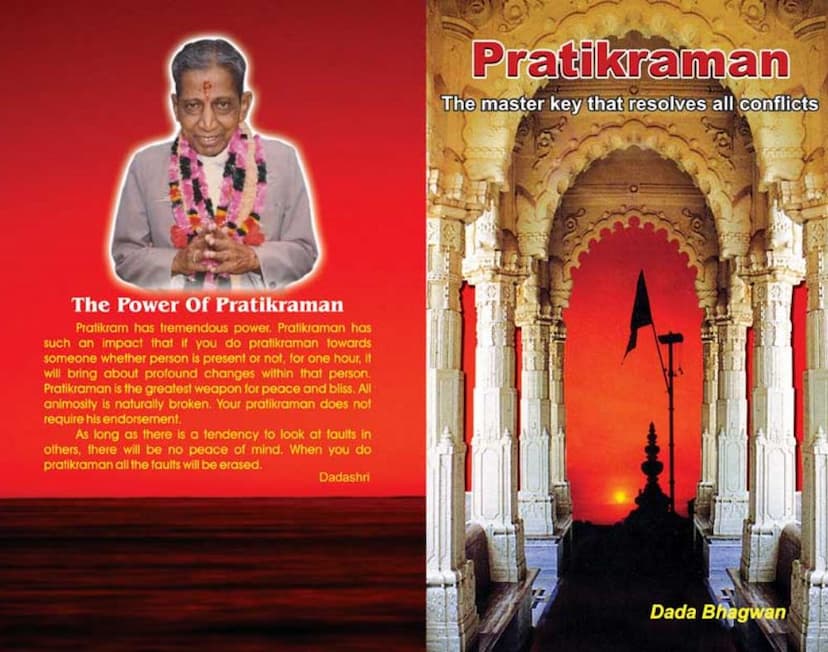Pratikramana Freedom Through Apology And Repentance
Added to library: September 2, 2025

Summary
This document is a summary of the Jain text "Pratikramana: Freedom Through Apology and Repentance" by Dada Bhagwan, published by the Dada Bhagwan Foundation. It focuses on the spiritual practice of Pratikraman, which is presented as a powerful tool for resolving conflicts, achieving peace, and ultimately attaining liberation.
Here's a breakdown of the key themes and teachings:
Core Concept: Pratikraman
- Definition: Pratikraman is defined as a process of apology and repentance for one's mistakes, spoken or unspoken, in thoughts, speech, or actions. It's presented as a "master key" to resolve all conflicts and the "greatest weapon for peace and bliss."
- Power and Impact: Doing Pratikraman, even for an hour towards someone (present or not), can bring about profound changes in that person. It's emphasized that one's Pratikraman does not require the other person's endorsement.
- The Essence of the Teachings: The core message is that as long as one tends to find fault in others, peace of mind will be elusive. Pratikraman is the method to erase these faults.
Key Principles and Practices:
- Alochana, Pratikraman, Pratyakhyan: These three are presented as the essence of true religion.
- Alochana: Confession of one's mistake as it is.
- Pratikraman: Asking for forgiveness and repentance.
- Pratyakhyan: A firm resolve and determination never to repeat the mistake.
- Witness to Repentance: Repentance should be done in the presence of one's believed God (e.g., Dada Bhagwan, Lord Krishna, Lord Shiva). Dada Bhagwan himself is presented as the inner Lord, Dada Bhagwan, within A.M. Patel.
- "Shoot-on-Sight" Pratikraman: The ideal practice is to perform Pratikraman immediately after making a mistake (atikraman). This helps in erasing faults as they occur.
- Internal Process: Pratikraman is an internal mental process, not an external action.
- Understanding "Nimit": When something negative happens, one should see the other person as a "nimit" (instrument) for the discharge of one's own past karma, rather than blaming them. The fault lies within oneself for harboring negative feelings.
- Akram Vignan: The teachings are rooted in "Akram Vignan," a direct and "step-less" path to Self-realization, as imparted by Dada Bhagwan. This path emphasizes understanding the Self and applying these principles.
- Eliminating Kashayas: Pratikraman is a primary method for diminishing the "kashayas" (anger, pride, greed, attachment, and abhorrence) that hinder spiritual progress.
- Freedom from "Doership": The teachings advocate moving away from the ego-driven sense of "doership." The Self is the knower, and the physical body and mind (referred to as "Chandubhai" or the relative self) are the ones that err and need to perform Pratikraman.
- Asking for Strength: For those not yet Self-realized, the practice of asking for inner strength from the Divine (Dada Bhagwan) is encouraged, particularly to support the intention of not repeating mistakes.
- Pratikraman for All Faults: Pratikraman is necessary for all forms of "atikraman" (aggression in thoughts, speech, and acts), including lies, insults, violence, and violations of vows. It's also important for subtle and even extremely subtle faults.
- Not About the Other Person: The primary purpose of Pratikraman is for one's own purification and liberation, not to change the other person.
- Continuous Practice: The book emphasizes the need for continuous and sincere practice, rather than performing rituals only once a year.
- The "Burnt Rope" Analogy: Karma weakened by Pratikraman becomes like a burnt rope – its form remains, but its binding power is gone.
Dada Bhagwan and Akram Vignan:
- Self-Realization: The book introduces Ambalal M. Patel (Dadashri), who experienced spontaneous Self-Realization in 1958, becoming an instrument of "Dada Bhagwan" (the Lord within).
- The Path of Akram Vignan: This path offers a shortcut to Self-Realization, allowing one to attain it quickly through a scientific process called "Gnan Vidhi."
- Continuation of Work: Dr. Niruben Amin continues Dada Bhagwan's work, sharing these teachings.
Specific Examples and Scenarios:
The book uses numerous question-and-answer sessions to illustrate how Pratikraman should be applied in various situations, such as:
- When experiencing negative thoughts or emotions.
- When interacting with difficult people.
- When dealing with interpersonal conflicts.
- When one makes mistakes knowingly or unknowingly.
- When facing addiction or bad habits.
- When dealing with injustice or seeing faults in others.
- When speaking harshly or lying.
- When experiencing sexual impulses.
- When farming and causing harm to plants or insects.
Conclusion:
"Pratikraman: Freedom Through Apology and Repentance" presents Pratikraman as a vital spiritual practice for self-purification and liberation. By sincerely confessing, repenting, and resolving not to repeat mistakes, one can overcome inner conflicts, purify oneself, and progress on the spiritual path, ultimately achieving freedom and bliss. The emphasis is on consistent, heartfelt practice and understanding the underlying science of karma and the Self.